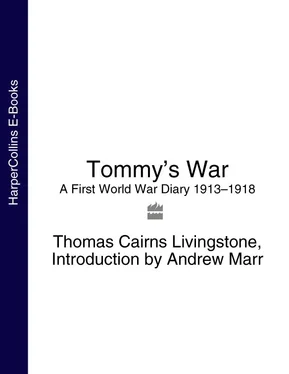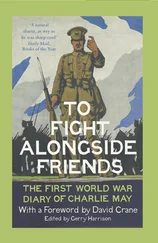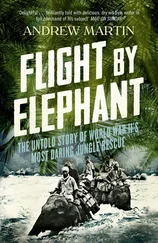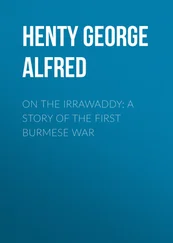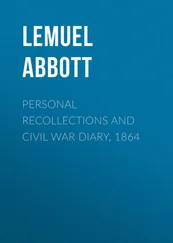TOMMY’S WAR
A FIRST WORLD WAR DIARY
1913–18
Thomas Cairns Livingstone
Edited by Ronnie Scott
Foreword by Andrew Marr

Dedication DEDICATION ABOUT THE DIARIES FOREWORD BY ANDREW MARR PEOPLE AND PLACES 1913 1914 1915 1916 1917 1918 1933 AND 1950 PICTURE CREDITS COPYRIGHT ABOUT THE PUBLISHER
In memory of
Thomas, Agnes and Wee Tommy.
COVER
TITLE PAGE TOMMY’S WAR A FIRST WORLD WAR DIARY 1913–18
DEDICATION Dedication DEDICATION ABOUT THE DIARIES FOREWORD BY ANDREW MARR PEOPLE AND PLACES 1913 1914 1915 1916 1917 1918 1933 AND 1950 PICTURE CREDITS COPYRIGHT ABOUT THE PUBLISHER In memory of Thomas, Agnes and Wee Tommy.
ABOUT THE DIARIES
FOREWORD BY ANDREW MARR
PEOPLE AND PLACES
1913
1914
1915
1916
1917
1918
1933 AND 1950
PICTURE CREDITS
COPYRIGHT
ABOUT THE PUBLISHER
Thomas Cairns Livingstone began writing his diary shortly before ‘flitting’ from 20 to 14 Morgan Street, Govanhill, Glasgow in 1913. Just why he started his diary has been lost to the annals of time, but a clue surely lies in his grandfather’s and father’s need to record their daily lives and their love of writing. Thomas’ grandfather was a teacher of English in Lurgan, Northern Ireland, his father, Joseph, kept an exquisite hand-illustrated journal of events deemed important to the Livingstone family. Perhaps Thomas was simply keeping up a family tradition he enjoyed, as well as marking the time that he first moved into his own home with his new family.
He had married Agnes Smart Cook (thinking that marrying A. Smart Cook he would never starve …) three years before moving to Morgan Street. The first few years of the diaries record – at the foot of each page – events of each day ten years earlier, when they were courting. Their son, Thomas Cairns Livingstone junior – invariably known as ‘Wee Tommy’ – joined the family in 1911 and was a toddler at the time of the move and the diaries’ commencement.
The diaries reveal how very well suited Thomas was to his job as a mercantile clerk. He had a pressing need to record all sorts of detail even, in many entries, the precise hour that he awoke and went to bed, with the discipline to maintain this long after most would have given up. Thomas never missed his daily entry for over twenty years, loyally filling each dated page of his clothbound diaries with his signature dry, humorous notes, observations and wonderful drawings, summarising the day’s events at home and further afield. Often a drawing is more telling than the words themselves, and he clearly meant one to be read against the other. From the accounts of other relatives, they were seen as something of a family treasure, and a list of each family visit is included in most volumes. In later years, Thomas enjoyed showing them off to his nephews and nieces.
After 1918 the diaries continue in their fine characteristic vein over the course of a further decade and a half, providing a very special snapshot of the post-war world and the unfolding Livingstone family pocket saga. Thomas ended his epic in 1933 as Wee Tommy started his working life at Glasgow University and old age caught up with Thomas senior. A very poignant last entry, dated 1950, records the death of his beloved wife, Agnes.
Upon Thomas’ death in 1964 the diaries passed to a less-than ‘wee’ Tommy, who remained his only child. He kept them until his own death in 1995, by which time he was living in Northumberland. The diaries were entered into a local county auction house in 2005 which, as a local antiques dealer, I happened to attend. There was something compelling about these twenty-odd little volumes nestled together in a shoebox, and I was able to secure them for the princely sum of £300.00.
That very weekend Thomas and his diaries quickly began to become part of my life. I read them cover to cover – including Joseph’s own volume of family records – utterly absorbed by the lost life stories spilling out from their pages of hand-written words and pictures. Some pages even had stamps from Thomas’ collection stuck on to them. It was like opening a time capsule. Every facet of life seemed to be recorded there, from glorious summers, heart-rending sadness of losing loved ones, frustrations with work, to his enduring love for Agnes. What seemed particularly special was being able to witness daily life and Wee Tommy growing up against the backdrop of the Great War, together with a chronicle of all the events in Glasgow and the rest of the Empire. As the war progressed, the bottom portion of every page – after tales of jam-making, walks in the park and seemingly constant redecorating of the front room (presumably because of the sooty fire) and blacking of the grate – sombrely lists the loss of life that each day’s newspaper had announced, together with any notable gains or military achievements.
Soon I found myself on the road in a quest to explore the life and discover more about this remarkable man from Glasgow and his family. I’m extremely grateful to Dr. Irene O’Brien and the wonderful staff at the Mitchell Library in Glasgow, and all the Livingstone relatives, Helen Carlyle, Ella Brown and Colin Brown, who have helped me in my quest, and with whom I’ve been delighted to share the details I’ve found about their ‘lost’ relative.
If you know more about Thomas than I have been able to uncover already, then I look forward to hearing from you – you’ll find the contact details at the back of this book.
When the BBC’s Antiques Roadshow rolled in to Alnwick Castle in July 2007, I couldn’t resist taking the diaries along. I found myself pulled out of a queue and ended up being filmed with books expert Clive Farahar. The episode was broadcast that autumn and caused a lot of interest from publishers and literary agents keen to bring the diaries to the nation’s attention. It was thrilling that in the end they were taken on by HarperCollins, themselves of Glasgow descent, and in whose blank diary pages Thomas Cairns Livingstone left his enduring mark.
At last, some of the best of the private diaries of Thomas Cairns Livingstone are ready to be enjoyed and treasured by everyone. A lot of people have worked on bringing this to fruition, but I’d like especially to thank my partner Joan for her patience and support; Gordon Wise of Curtis Brown for offering to take on their representation; Michael Morrison, whose mother was ‘wee’ Tommy’s great friend and heir; John Bond and Arabella Pike and all the team at HarperPress for all the hard work in assembling this edited volume of the years 1913-1918 and sourcing such suitable photographs to complement Thomas’ illustrations and stories; Dan Cruickshank, for his early enthusiasm; and Ronnie Scott, for bringing those stories to life for the uninitiated, picking out storylines and providing background notes to enable us to understand Thomas Cairns Livingstone’s world more than a little better.
Shaun SewellNorthumberland, June 2008
A small man in a badly made suit, a hat jammed on his head and an empty pipe between his lips, is walking down the street towards the tram, with a small boy attached to one hand, in turn clutching a mouth organ. Around him are men in uniform, loud gossipy women on the corner, the rattle of horse-drawn carts, the smells of sulphur, oil, coal and sweat. On the walls as he passes, lurid recruiting posters urge him to join the lads in France, to fight to save his women from the Hun, or simply exclaim that his country needs him. Head down, fingering his last stiff collar, he disappears into the crowd gathering by the tram stop. The streets are shabby and the war news is terrible. There is a faint sound of the mouth organ being played. Who is he, this man? What does he do? Does he have a wife at home, her hands coarsened with heavy washing and scouring, but her bread smelling sweet? Will he soon be wearing a khaki uniform, and die choking in French mud thinking of the small boy; or will he survive this so-called Great War? Does he like cards? What does he think of Germans, and this throbbing, clattering city where he has spent his life? But he has gone, vanished into time like the millions upon millions who lived through momentous times but who were not Lloyd George, or Haig, or even Harry Lauder.
Читать дальше
